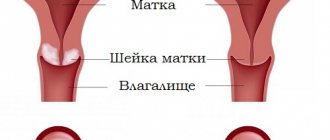Some women, when carrying out hygienic procedures, may feel a tubercle on the cervix, let’s try to figure out what it is. It’s worth saying right away that such formations are far from uncommon, but in most cases they do not pose a threat to the health and life of the girl.
Medical opinion in this regard is ambiguous. Some experts argue that therapy is necessary, while others, on the contrary, assure their patients that regular regular monitoring is sufficient. In some situations, a tubercle on the cervix indicates a serious illness, but not many people know how to determine this. Therefore, the topic should be disclosed as completely as possible.
Causes
If a woman has a lump on the cervix, then the likelihood that it will manifest itself in any way and cause concern is minimal. It is detected during a gynecological examination or self-examination.
However, in order to unambiguously understand why lumps appeared on the cervix, the examination must be comprehensive, including colposcopy, tests to detect infections, determination of the composition of the microflora, hormone levels, and tumor markers. Also, any diagnosis for gynecological diseases or to confirm pathology involves performing an ultrasound scan.
A lump-shaped formation on the cervix. Source: stoprak.info
Lump on the cervix - what it could be (consider options):
- Polyps - if the necessary therapy is not carried out, then it is possible that the nature of the course of the pathology will change and it will degenerate into a malignant disease.
- Papillomas and condylomas - in this case, tubercles on the cervix indicate that the human papillomavirus (HPV) has been activated in the body; a thorough examination is necessary, since some of its strains are oncogenic.
- A tumor on the cervix of a malignant nature - pathologies pose a serious danger to a woman’s health and can also cause death.
- Myoma nodes - on the cervix of the uterus, a growth of this type is formed from its own cellular tissue. Gradually increasing, they begin to protrude beyond the organ, which allows them to be detected even independently.
- Nabothian cyst - if there is a tubercle on the cervix, what is it, a photo of it should be compared with this formation, since it is quite often diagnosed in women of different ages. A ball of glandular tissue is formed, has a capsule shape, and is filled with liquid (mucus) inside. If the formation is less than 1 cm, it does not pose a threat and only requires constant monitoring.
- Cervical erosion - situations where a formation appears on the cervix are extremely rare, but they occur in conjunction with the erosive focus itself and wounds. It can even be detected by palpation in women of different ages.
All of the diseases presented can cause a woman to form a ball on the cervix.
Why are they formed
Lumps on the cervix most often do not manifest themselves; women may discover them by chance during a self-examination of the cervix or during a routine examination by a gynecologist. To determine the cause of the formations, it is necessary to undergo a comprehensive examination, which includes colposcopy, testing for sexually transmitted infections and vaginal microflora, determination of the level of hormones in the blood and tumor markers, and pelvic ultrasound.
Tubercle on the cervix - what could it be:
- polyps - without proper treatment they can degenerate into malignant tumors;
- papillomas, condylomas - a sign of activation of the papillomavirus, some strains are oncogenic;
- malignant tumors of the cervix are one of the main causes of early mortality among women;
- myomatous nodes - formed from muscle tissue cells of the cervix, as they grow, they begin to protrude significantly, it is not difficult to notice them even on your own;
- Nabothian cyst is a common gynecological pathology, which is a gland in the cervix overflowing with mucus. The pathology is subject to observation and is not dangerous in small (up to 1 cm) sizes;
- cervical erosion - in rare cases, in addition to wounds and ulcers, small tubercles appear that can be felt; the problem is diagnosed in many women of different ages.
Symptoms
Often after childbirth, girls develop lumps on the cervix, what this is can be explained by the doctor after a thorough examination of the patient. Such situations are a common occurrence for those who had this process with certain complications, for example, there were tissue injuries, then scars formed, and it is in these places that the cervix will be lumpy to the touch. In the absence of pain, discomfort and other unpleasant sensations, such formations do not pose a danger.
However, if a lump on the cervix, a photo of which can be viewed on specific resources and ultrasound images, bothers a woman, pain appears when pressing on it, and it also rapidly increases in size, an urgent consultation with a doctor is required. Almost any gynecological disease, if treated at the initial stage, can be easily eliminated.
Diagnostics
Diagnostics includes several types of laboratory and instrumental examination methods.
- gynecological examination. This is the first stage of any diagnosis of pathologies of the reproductive system. During it, the doctor examines the condition of the cervix, vagina, evaluates the structure, size and nature of the tumors;
- Ultrasound examination of the pelvic organs. This method allows you to find out whether there are any inflammatory processes, as well as accurately determine the location of cervical growths;
- smear examinations. It is carried out to study the cells of the cervix and allows you to detect malignant formations;
- hysteroscopy. The method is similar to ultrasound, however, in this case, a hysteroscope is inserted into the uterine cavity, which allows not only to determine the size and number of growths of the cervix, but also to take biomaterial for further research;
- metrography. The essence of the method is to study the relief of the cervix and uterine cavity with the additional introduction of a contrast agent.
Polyps
A neoplasm on the cervix may be a cervical polyp. They are some kind of growths of the mucous membrane of the cervical canal. Its main symptom is the sensation of a tubercle on the surface of the organ. As for the frequency of diagnosis, a lump on the cervix the size of a pea (slightly larger or smaller than this size) is detected in women during menopause.
Doctors assure that such a tumor on the cervix is benign, but if you do not control the process of its vital activity and do not carry out proper treatment, you may miss the moment when it begins to transform into a malignant formation. This is what colposcopic images look like for a benign cervical tumor (shown below).
Colposcopic photo of the tumor. Source: turistam.net
We will also consider the factors under the influence of which polyps form on the reproductive organ of women:
- Inflammatory and infectious diseases of a chronic nature, including cervicitis, adnexitis, endometritis, venereal pathologies;
- Hormonal imbalance - in this condition, the functioning of the ovaries is disrupted, which often leads to an increase in the level of estrogen production, and progesterone, in turn, decreases, as a result of which the mucous membrane of the organ thickens and a tubercle appears on the cervix, a photo of which can be seen in the article;
- Injuries to the mucous membrane of the cervix of various etiologies: abortion, curettage for medical reasons, complicated childbirth;
- A neoplasm on the cervix can be a consequence of stressful situations, constant overexertion, depression, psycho-emotional shock;
- A lump on the cervix may appear as a result of pregnancy, diabetes or dysbiosis in the vagina.
Many women are interested, having noticed that they have a lump on their cervix, what it could be - with a high probability we can talk about the formation of a polyp. In this case, a frequent accompanying symptom will be copious discharge of secretions from the vagina mixed with blood in the middle of the menstrual cycle. It is possible that the leucorrhoea will change its character, it may become gray with an admixture of pus, pain appears in the lower abdomen and lumbar region.
A small ball on the cervix can cause a woman to feel pain or discomfort during intimate contact. As for menstrual bleeding, they also change their character, become long and profuse, and the development of infertility cannot be ruled out.
Main methods of treatment
Benign lumps on the cervix are treated using the following methods:
- cryotherapy;
- laser therapy;
- cauterization with liquid nitrogen;
- radio wave therapy.
The radio wave method is considered the most gentle method of treatment. It is used to remove benign growths when planning pregnancy.
Drug therapy
For polyposis, drug treatment is used:
- hormonal contraception;
- antibiotics;
- with anti-inflammatory effect;
- vitamin complexes.
Surgery
Balls that have not reached a significant size are removed by cauterization. Small abscesses are punctured. For significant nodes, surgery is performed.
Intervention may be required for polyposis. The procedure is performed using a hysteroscope under visual control.
A gentle type of operation that preserves reproductive function includes treatment of the tubercle with a laser beam.
Cyst
Having felt the tubercles on the cervix, every woman is interested in what they are. Gynecologists say that this may be a cystic formation. The fact is that on the surface of the organ there is a mucous membrane containing Nabothian glands. Thanks to them, mucus is released, which acts as a protective barrier against pathogenic and opportunistic microorganisms. If there is a malfunction in the reproductive system, the duct becomes clogged, fluid accumulates in it, the pathological area swells and a cyst forms.
It is not enough to feel a formation on the cervix, what it could be, and what the reasons for its appearance also need to be considered. So, following medical data, experts identify the following reasons for the development of cystic formations:
- The period of healing of the genital organs after labor;
- Infectious lesions of the reproductive organs;
- Menopause.
If there is a lump on the cervix the size of a pea (photos can be seen in the article), they do not show any signs. However, they gradually increase in size, as a result of which the woman begins to feel discomfort in the lower abdomen and pain during sexual intercourse. The same symptoms are present in malignant formations.
Lumps with fibroids
Myoma is a benign tumor process that affects the muscular layer of the cervical canal in the cervix. Minor tubercles can provoke the development of hormonal imbalance and infertility.
Reasons for the development of fibroids:
- hormonal disorders;
- genetic factor;
- lack of regular sexual activity after 25 years - blood circulation in the uterus is disrupted, myomatous tubercles appear;
- late birth;
- obesity, thyroid dysfunction, diabetes;
- abortions, curettage, gynecological surgeries.
With fibroids, the duration of menstrual bleeding and its volume increases, and discharge mixed with blood appears in the middle of the cycle. Pain in the lower back and lower abdomen. As the bumps grow, they begin to put pressure on nearby organs, which leads to problems with bowel movements and urination.
Types of condylomas
Condylomas are flat and pointed.
- Flat ones grow deep into the layers of the epithelium . They are caused by types of HPV that are highly likely to cause a malignant process.
It is very difficult to identify cells that have been infected by the virus. They do not rise above the surface of the fabric, do not have a specific color, and are usually small in size. Flat condylomas are prone to malignancy , which is very dangerous. Genital warts are evidence of an acute viral disease . More often they appear simultaneously, and represent an elevated growth in the superficial spheres of the epithelium, connected to it by a thin stalk. The shape of the formation resembles seaweed.
The shade of condylomas is pale pink. Genital condylomas can be easily visualized during examination, so they are detected more often than flat ones. If left untreated, they tend to grow.
Growth on the outside of the cervix
Only papillomas and cysts manifest themselves externally; all other lumps and growths are characterized by a deeper location. Fibroids are formed in the uterine mucosa; polyps are characterized by the growth of the endometrium inside. When examined by a doctor, the main criterion will be the pain of the tumors, bleeding and the degree of growth - single or multiple. Treating growths after chronic inflammation is easier than fighting a virus or hidden infection, but it is not advisable to start the process. After treatment, it is necessary to observe a doctor for some time to avoid relapse. Typically, you visit a gynecologist every 3 months, then every six months, until the likelihood of a recurrence of the disease is minimized.










